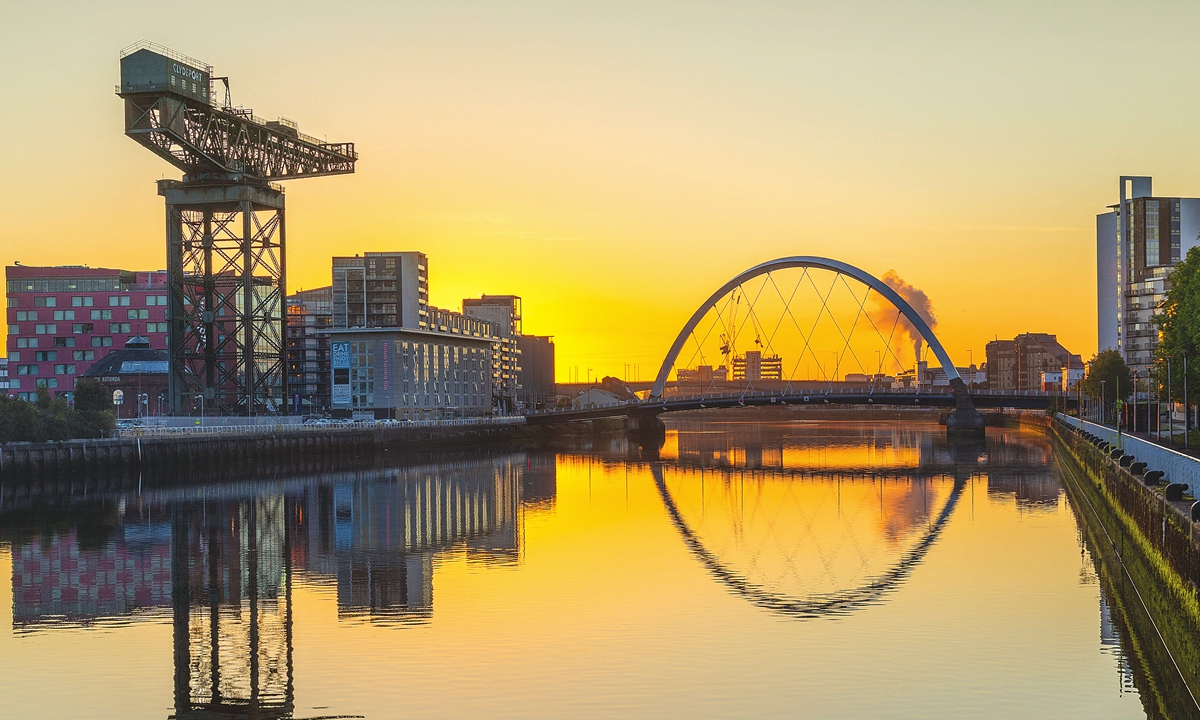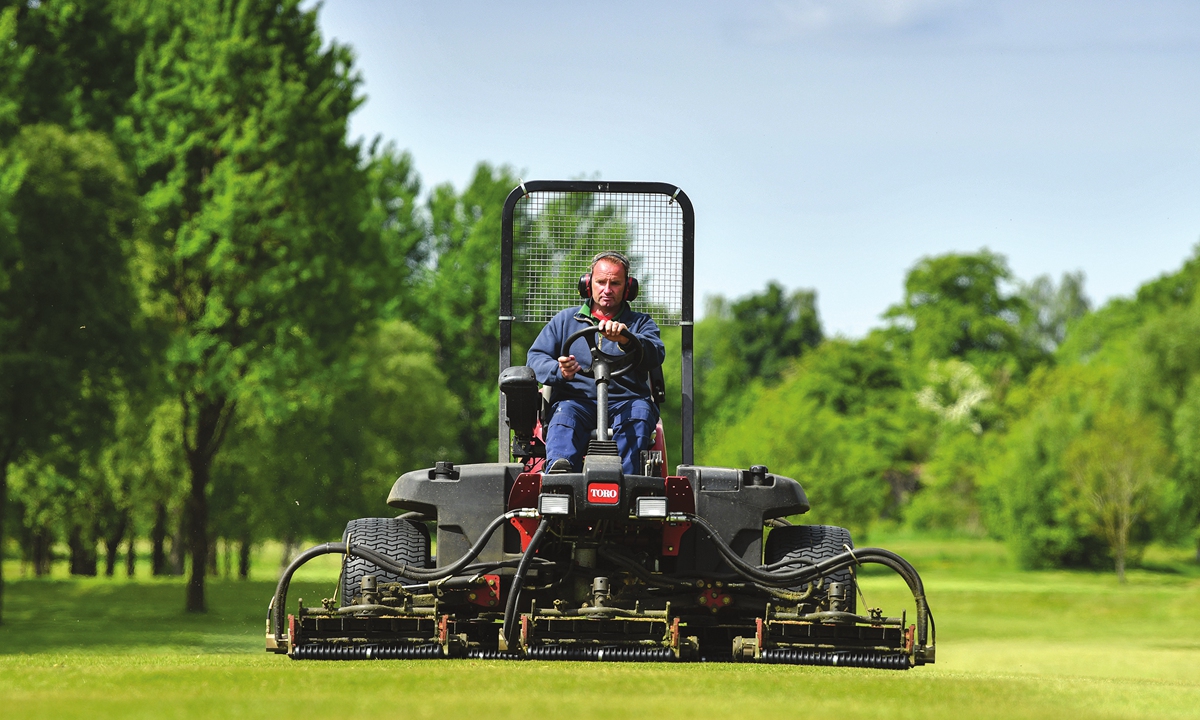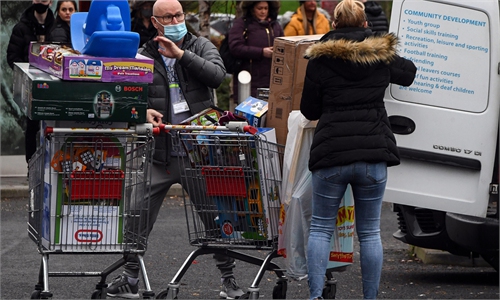
Sunrise over River Clyde in Glasgow, the UK Photos: AFP

A greenkeeper prepares Cowglen Golf Course in Glasgow, the UK in May 2021. Photo: VCG
When her first electricity bill arrived, Hollie Osborne's dream of a "forever home" for herself and her two-year-old son began to fade.
Her flat in a new social housing development, built in a handsome red-brick former school in Glasgow, represented a chance for the single mother to rebuild her life, after struggling with serious mental health issues.
But as the harsh Scottish winter set in, the heating needed to be on constantly to stay warm - and the 150-pound ($200) monthly bills that began arriving represented half her income.
"I was having to bring my boy in bed beside me, just because I couldn't afford to put the heating on," Osborne said.
A spokesperson for the Home Group Scotland housing association that owns and manages the property said it was working to resolve issues with heating in some flats and offering support to tenants who had received high bills.
Several miles up the road, Tizo Seleman and his partner Saada Mwalimu, both care workers who live with their baby daughter in a high-rise block in Glasgow's Springburn district, expect their once-onerous heating bills to shrink.
In July, their inefficient old heaters were replaced with a low-carbon air-source heat pump system - part of a bid by their social housing landlord to make heat cheaper for tenants and slash climate-changing emissions.
"I think it will make a real difference," predicted Seleman.
Glasgow, a former industrial hub that will host the key COP26 UN climate negotiations in November, is one of those trying to drive the shift as part of the C40 Cities network, a group of nearly 100 major cities worldwide working for faster action on climate change.
In Glasgow, which has pledged to reach net-zero emissions by 2030, which includes pulling water-source heat from the city's river, improving public transport, and planting more urban trees.
It also is working to find ways to make homes climate-smart, comfortable, and cheaper to heat while ensuring those least able to afford the green shift are not left out.
That is not an easy job in a port city noted for its winter cold, where around a quarter of residents pay more than 10 percent of their income for heat and restrictions on how historic homes can be modified make retrofits challenging.
About 15 percent of Scotland's emissions come from heating homes, which makes finding low-carbon ways to keep families warm a priority as Britain aims to slash its emissions by 78 percent by 2035.
Heat versus heritage
While Glasgow looks to the future, its streets are largely shaped by its past.
The city is known for its sweeping terraces of red and blonde sandstone tenements - properties built in the late 19th and early 20th centuries that contains multiple flats and make up about a fifth of Glasgow's homes, according to the council.
The tenements - beloved for their high ceilings, original fireplaces, and other features - are also considered chilly and sometimes damp, while their stonework and historic features make efficiency upgrades more challenging.
But one inner-city project aims to produce a blueprint for revamping them to modern energy efficiency standards without losing their character.
The retrofit aims to reduce energy bills for homeowners by up to 90 percent. How the building functions will be monitored by researchers, with data used to inform future tenement upgrades.
River power
As Glasgow looks for new green energy sources, it is turning in part to the wide Clyde River that winds through its city center.
In much the same way as air-source heat devices work, large water-source heat pumps could draw residual heat from the Clyde, which is then piped to homes and businesses, providing a lower-carbon alternative to traditional heating systems.
The river is already fueling one district heat network serving homes and businesses just outside Glasgow, and another planned system will power a high-tech "innovation district" in the center.
One catch is that although renewable systems can compete on price with heat produced from fossil-fuel electricity, the gas boilers that still warm most homes remain even cheaper.
Who pays?
As leaders prepare to gather at the COP26 talks in Glasgow to hammer out rules designed to ramp up emissions cuts, one crucial question will be how to finance it all.
Glasgow City Council leader Aitken said reaching the city's aim of net-zero emissions by 2030 is likely to require about 30 billion pounds ($41 billion) of investment, including 5 billion pounds just to retrofit homes to higher efficiency standards.
"Governments alone can't deliver this. We need to have private investment come in," she said.
The city will launch an investment prospectus around the time of the COP26 conference, laying out 10 major projects.
Glasgow will work to make the voices of city leaders heard at the summit, she said, calling cities crucial players in the race to reach net-zero goals.
"Cities are where most of the emissions are generated because it's where most of the people are - but it's also where you get the biggest gains in decarburization most quickly," she added.
Reuters



